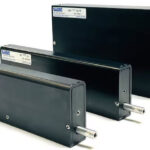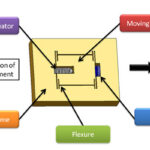Moticont has released the GVCM-022-013-01 linear voice coil servo motor. This compact 0.875 in. (22.2 mm) diameter high speed, high force-to-size linear motor features high accuracy and high repeatability when operated in a closed loop as a dc servo motor. This brushless servo motor is clean, quiet and has long life, low mass and high […]
Mini + piezo + voice coil
Hollow-core linear voice coil servo motor features 19.1 mm stroke, high force-to-size ratio
The HVCM-051-032-013-01 Linear Voice Coil Motor from Moticont features a high force-to-size ratio and a 19.1 mm (0.75 in.) stroke. The motor is a low inertia, high acceleration/deceleration, high speed, clean and quiet, non-commutated, hollow core brushless servo motor. A true dc servo motor, it can be used to achieve resolutions of less than 1 […]
Miniature voice-coil servo motor features half-inch stroke
Newly released from Moticont, the miniature GVCM-019-022-02 Linear Voice Coil Servo Motor, is just three-fourths of an inch (19.0 mm) in diameter and features a half inch (12.7 mm) stroke. This small linear actuator, also referred to as an electric cylinder, features 8.4 oz (2.3 N) of continuous force and 26.6 oz (7.4 N) of […]
Electric cylinders feature 1.25-micron resolution
Moticont has released new metric and imperial dimensioned electric cylinders or linear voice coil servo actuators. The new compact 25.4 mm (1.000 in.) stroke SDLM-025-095-01-01M and SDLM-025-095-01-01 linear dc servo actuators feature high repeatability, high acceleration/deceleration, and zero cogging. These high force-to-size electric cylinders have linear encoders mounted internally for closed loop servo operation. Additionally, […]
Linear voice coil servo motor features high force, 2.25 in. length at mid-stroke
Moticont has added a high-force linear dc servo motor to their expanding line of voice coil or moving coil motors. The LVCM-095-038-01 linear voice coil motor is a true servo motor featuring zero cogging, high accuracy, and high repeatability when operated in a closed positioning loop. Clean non-commutated, zero cogging, zero backlash voice coil motors […]
New miniature voice coil motor from Moticont features 0.125 in. open aperture
Moticont has debuted its most compact miniature hollow core linear actuator; the HVCM-016-010-003-01 linear voice coil motor, featuring a 0.125 in. (3.2 mm) open aperture and high force-to-size ratio. This miniature open aperture actuator is a true dc linear servo motor. Quiet and clean, this non-commutated, miniature brushless servo motor features: Zero cogging and zero […]
Miniature voice coil servo motor features high force-to-size ratio, 1-micron resolution
Moticont’s new miniature GVCM-016-019-01M linear voice coil servo motor is smaller in diameter than a U.S. dime. This 15.9 mm (0.625 in.) diameter servo motor, also called an electric cylinder, features a high force-to-size ratio of 1.5 N (5.3 oz) continuous force and 4.6 N (16.6 oz) of peak force. The compact housing is just […]
Programmable linear actuator features stroke to 100 mm
The new LDL Programmable Electric Linear Actuator from SMAC Moving Coil Actuators has been designed as a cost-competitive alternative to pneumatics. A common trend in industrial automation is that engineers are looking for electric alternatives to pneumatic components for a number of reasons, including increased control, improved cycle life, and reduced operating cost. The LDL […]
Comparing micropositioning and nanopositioning stages
Linear stage designs can range from long-stroke, high-load gantries to micropositioning and nanopositioning stages with light payloads. Although all linear stages are designed and constructed to provide high positioning accuracy and repeatability and to minimize angular and planar errors, stages for micropositioning and nanopositioning applications require additional considerations in component selection and design to achieve these […]
What are piezo flexure stages and how do they work?
Piezo actuators provide highly responsive, rapid movements, but their displacement is limited to just 0.1 to 0.2 percent of the actuator length. To overcome this limited stroke capability, a piezo actuator can be combined with elements, such as flexures, that provide mechanical amplification. The amplification provided by a flexure mechanism can extend the stroke of […]




